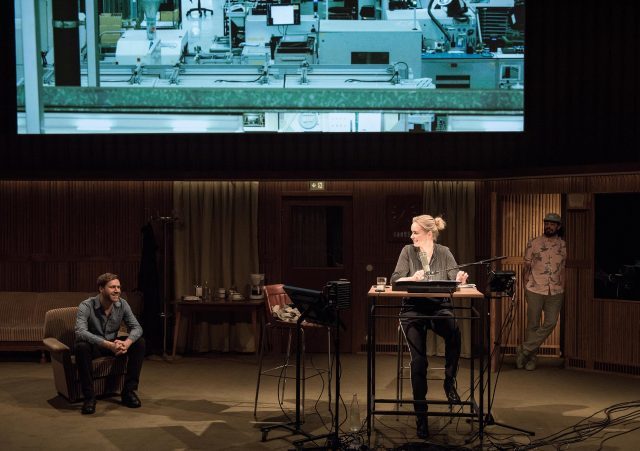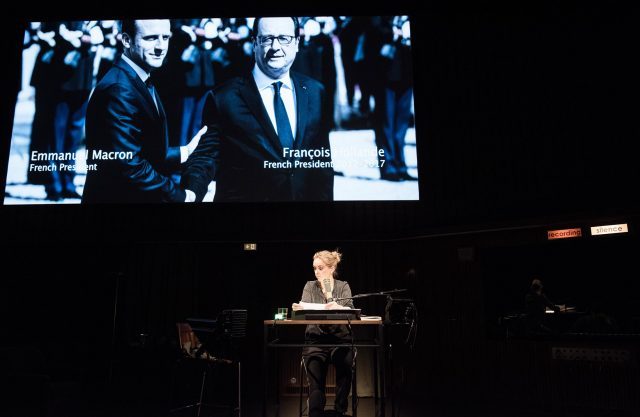
Paul (Bush Moukarzel), Katy (Nina Hoss), and Toni (Ali Gadema) get down to business in Returning to Reims (photo by Teddy Wolff)
St. Ann’s Warehouse
45 Water St.
Tuesday – Sunday through February 25, $46-$56
718-254-8779
stannswarehouse.org
www.schaubuehne.de
Politics become personal — and vice versa — in Schaubühne Berlin’s multilayered, highly intellectual, and hypnotic Returning to Reims, which opened last night at St. Ann’s Warehouse in Dumbo. “It’s multilayered. It’s multilayered filmmaking. That’s my style,” director Paul (Bush Moukarzel) explains to actress Katy (Nina Hoss) as studio engineer Toni (Ali Gadema) looks on and the audience laughs, in on the joke; the quote is a reference to Returning to Reims director Thomas Ostermeier himself, a man not known to take the easy route in the many multilayered works he has made with Schaubühne Berlin, most recently evident in the fierce, unforgettable Richard III the company staged at BAM late last year. As the audience enters the theater at St. Ann’s, Paul and Toni are immersed in conversation in their glassed-in tech booth in a large, spare recording studio (austerely designed by Nina Wetzel, who also did the costumes); between them, on the back wall, is a copy of Gil Scott-Heron’s 1970 album, Small Talk at 125th and Lenox. They leave to get coffee and Katy walks in and begins rehearsing her reading of French writer and philosopher Didier Eribon’s 2009 memoir, Returning to Reims. Toni and Paul return and Katy starts her performance within the performance, reading in a subtle, deliberate monotone that is mesmerizing.
Her reading is accompanied by projections on a big screen behind her, archival footage in addition to newly filmed scenes (by Ostermeier and Sébastien Dupouey) of Eribon returning to Reims and speaking with his mother in her home. What at first appears to be the recording of an audiobook is revealed to be narration for a documentary about Eribon and his book, in which he examines his relationship with his father, his family’s communism, his homosexuality, and the social contract. “In taking as my point of theoretical departure the idea that the complete break I had made with my family was due to my homosexuality . . . had I not at the same time offered myself reasons for avoiding the thought that this was just as much a break with the class background I came from?” Eribon’s very French investigation of pedigree and sexuality asks, continuing, “I was a class traitor, one whose only concern was to put as much distance as possible between himself and his class of origin, to escape from the social surroundings of his childhood and his adolescence.”

Nina Hoss is mesmerizing in Thomas Ostermeier’s inventive adaptation of Didier Eribon memoir (photo by Teddy Wolff)
As actress and director begin to spar, conspiracy theories, discussions of wealth and power, and what to do about genuine evil emerge from the text, while efforts to define the responsibilities of actress versus director illuminate the mutual responsibilities of citizens to call out injustice. Katy continues to act up, telling Paul that the images being projected are confusing and don’t relate to what she is reading. She is not just complaining about Paul’s choices as director — and Ostermeier’s too, since some of the projections are just as confusing to the audience — but also questioning the very nature of audiovisual storytelling, both film and theater, self-referentially reflecting, perhaps, on the creation of the play itself. All the characters go home and come back a week later for the next session, in which Paul breaks the fourth wall, Toni raps, Gil Scott-Heron upends the social order with “Whitey on the Moon” (“I can’t pay no doctor bills / but whitey’s on the moon / Ten years from now I’ll be payin’ still / while whitey’s on the moon”), and Katy relates Eribon’s family experiences to those of her own, in essence asking each one of us where we fit in. “Basically it reminds me of my father; he was born in 1929, the same year of Eribon’s father,” Katy says. But it’s really Hoss’s own family she is talking about; her father was a cofounder of the Green Party in the Bundestag, and it’s clips from his life that are being projected onscreen. “He had the same background, he came from the working class, from a communist family, but he chose not to surrender to the circumstances. He went a different way. It would be good to have a little bit of that in the film. A little bit of hope,” Katy tells Paul.
Hoss (Phoenix, Barbara), perhaps best known in America as German intelligence agent Astrid on Homeland, is magnetic as Katy, the rhythm of her delivery floating in the air and reaching deep into your body; even though she spends most of the time looking down and reading, it’s nearly impossible to take your eyes off her, except to glance at what’s on the screen. Meanwhile, the score by Nils Ostendorf and the sound design by Jochen Jezussek surrounds the audience from all sides. The two-hour Returning to Reims occasionally veers off track, but Ostermeier (An Enemy of the People, The Cut) always steers it back with the help of Hoss; the two previously collaborated on Schaubühne Berlin’s The Little Foxes and Bella Figura. It’s multilayered with extra helpings of meta; in fact, it works better the more poetic license and theatrical leeway you give it as Ostermeier lifts Eribon’s words to a global level in an age where identity politics and neoliberalism are failing and populists have seized the day around the world. “I’m just thinking about the ending. Why you’re ending it like this,” Katy says to Paul. “Now you’re ending with this big task for the Left. Who’s going to do this? It’s a kind of classic, didactic ending.” In Ostermeier’s vision of society, there is a lot to be learned, and done, and the arts are as good a place as any to start.